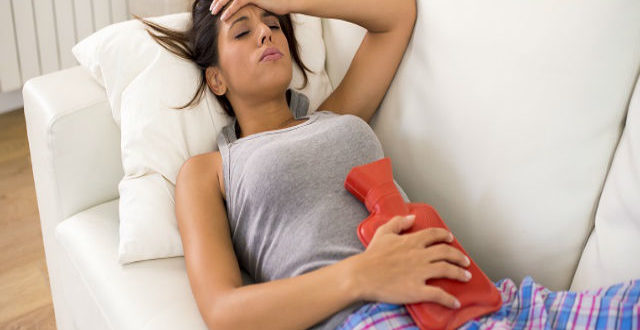-
Oh, my! It’s that time of the month again when you have to deal with all the cramping, bloating, and, of course, the bleeding – sounds familiar, ladies? Periods are frustrating, and while some women barely feel their wrath, for many others, the monthly aunt flow can be quite an ordeal. Dealing with irregular periods and bearing with the excruciating pain those four days and the lead up to it is not the best feeling in the world.
It is such an essential part of being the woman you are. Embrace it! Yoga will help you do so
1. Adho Mukha Svanasana
Downward facing dog pose or Adho Mukha Shvanasana is an asana which is pronounced as A-doh MOO-kah shvah-NAS-anna. Sanskrit: अधोमुखश्वानासन; Adho – Forward; Mukha – Face; Svana – Dog; Asana – Pose;
The name comes from the Sanskrit words adhas (अधस्) meaning ‘down’, mukha (मुख) meaning ‘face’, śvāna (श्वान) meaning ‘dog’, and āsana (आसन)
meaning ‘posture’. The Adho Mukha Svanasana looks similar to a how a dog looks when it bends forward. This asana has numerous amazing benefits that make it extremely essential for you to practice it every day. The best part is, even a beginner can get the hang of this asana with great ease. know more …
2. Dhanurasana
Sanskrit: धनुरासन; Dhanur – Bow, Asana – Pose; Pronounced As dah-noo-rah-sah-nah
Dhanurasana or the Bow Pose is one of the 12 basic Hatha Yoga poses.
It is also one of the three main back stretching exercises. It gives the entire back a good stretch, thus imparting flexibility as well as
strength to the back.
3. Ustrasana
Ustrasana, Ushtrasana, or Camel Pose is an asana. Sanskrit: उष्ट्रासन; Ustra – Camel, Asana – Pose; Pronounced As oos-TRAHS-anna
This asana, popularly called the Camel Pose, is an intermediate level backward bend. Ustra means camel in Sanskrit, and this pose resembles a
camel. It is known to open up the heart chakra and increase strength and flexibility. This asana is also commonly referred to as the
Ushtrasana.
4. Malasana
Malasana also known as the garland pose, squat pose is an asana. Mala Garland, necklace, Asana – Pose; Pronounced As – maa-laa-sa-na
Malasana is also called Upavesasana or Garland Pose. It is, quite
simply, a squat. Squatting comes naturally to kids and people who work in the fields. However, those who have desk jobs have lost practice and
find it painful and uncomfortable to do it. But that should not discourage you from doing this asana because it is, in fact, most
beneficial to those who have a sedentary lifestyle.
5. Matsyasana
Matsyasana or Fish Pose is an asana. Sanskrit: मत्स्यासन; Matsya – Fish, Asana – Posture; Pronounced As – mot-see-AHS-anna
When you look back, Hindu mythology states that Matsya was an incarnation of Lord Vishnu, the preserver of the Universe. It is said
that the earth had become corrupt, and a flood was going to wash away the earth. Vishnu donned the avatar of a fish, called Matsya, and
transported all the sages to safety, thus ensuring all their wisdom was preserved. This asana aims at being focused and resilient when you feel
out of balance, just as the Matsya struck that balance between the earth and the sea.
6. Paschimottanasana
Paschimottanasana is a seated forward bend that stretches the entire back of the body, from the head to the heels. This pose can help to relieve stress and anxiety, improve blood circulation, and calm the mind. It also stretches the muscles in the pelvic area, which can help to alleviate menstrual cramps and regulate periods.
7. Bhujangasana
Bhujangasana is a gentle backbend that stretches the muscles in the chest and abdomen. This pose can help to improve circulation, reduce stress and anxiety, and stimulate the reproductive organs. It also strengthens the muscles in the pelvic area, which can help to alleviate menstrual cramps.
8. Balasana
Balasana is a gentle resting pose that can help to alleviate stress and anxiety, improve digestion, and calm the mind. It also stretches the muscles in the pelvic area, which can help to alleviate menstrual cramps.
To practice this pose, kneel on the ground. Take a deep breath, spread your knees as wide as your hips, and try to touch your toes together. Then slowly bend your head between your thighs as you exhale. Your shoulders must lie on your hips.
How Does Yoga Help Solve The Period Problem?
Yoga is extremely effective when it comes to curing irregular periods and heavy blood flow and alleviating the cramps and pain. Yoga is the best medicine, and it cures all menstruation-related problems. Here’s
how:
- It stimulates the reproductive organs, which leads to their better functioning
- .It reduces stress and completely relaxes your mind and body.
- It regulates your metabolism, therefore allowing you to maintain your ideal weight.
- It works on your hormones and balances them out.









